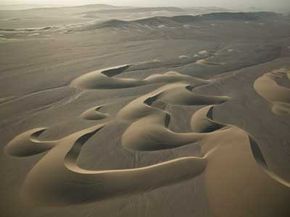Types of Sand Dunes
Sand dunes develop into all shapes and sizes, but that doesn't stop scientists from piling them into generalized categories. By using satellite and aerial photography of the world's deserts, the United States Geological Survey (USGS) has identified five types of sand dunes:
- The crescentic dune, also called the barchand dune, is the most common type of sand dune. As its name suggests, this dune is shaped like a crescent moon with points at each end, and it is usually wider than it is long. Crescentic dunes form when winds blow from one direction. This dune traverses desert surfaces faster than any other type of dune. The migrating dunes in China are crescentic dunes.
- The linear dune is straighter than the crescentic dune with ridges as its prominent feature. Unlike crescentic dunes, linear dunes are longer than they are wide -- in fact, some are more than 100 miles (about 160 kilometers) long. The ridges are long and snakelike, and these dunes usually occur in parallel sets separated by other sand, gravel or rocky corridors.
- The star dune has arms that radiate out from a center pyramid-shaped mound, hence the descriptive name. Star dunes grow upward instead of outward and are a result of multidirectional winds. Common to the Sahara Desert, they tend to show up around topographic barriers. They're among the tallest sand dunes on Earth -- some star dunes in China are more than 1,600 feet (500 meters) tall.
- The dome dune is rare, oval- or circular-shaped and has no slip face. Dome dunes sometimes appear at the ends of crescentic dunes. Most dome dunes are low -- only a few feet high.
- The parabolic dune is U-shaped, but differs from the crescentic dune because its crests point upward, with elongated arms that follow behind. A parabolic dune's trailing arms are typically anchored by vegetation. The longest known parabolic dune has a trailing arm nearly 7.5 miles (12 kilometers) long.
Coastal sand dunes are a bit different from desert dunes. They form when an accumulation of sand blows inland from the beach. Coastal dunes always form in the predominant wind direction, but their shape and size depends on the shape of the beach. If a beach is shallow-sloped, more sand deposits on the shore, resulting in bigger dunes. On a steep beach, more sand washes back out to sea, and the dunes are smaller. Coastal dunes are a unique ecosystem, and they help to protect the surrounding area from erosion. Vegetation like dune grass acts as a stabilizer for coastal dunes.
Advertisement
Interestingly, scientists have recently confirmed the existence of sand dunes underwater, using advanced sonar equipment. Called sand waves, they can reach up to 700 feet (213 meters) long and more than 30 feet (9 meters) high. Changing tidal patterns, sediment and erosion help these underwater dunes to form.
